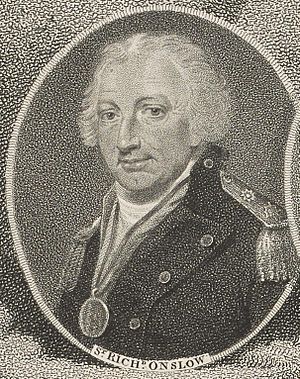Sir Richard Onslow, 1st Baronet facts for kids
Quick facts for kids
Sir Richard Onslow
|
|
|---|---|

Print by Piercy Roberts
|
|
| Born | 23 June 1741 |
| Died | 27 December 1817 (aged 76) Southampton |
| Allegiance | United Kingdom |
| Service/ |
Royal Navy |
| Years of service | c.1758–1817 |
| Rank | Admiral |
| Commands held | HMS Martin HMS Humber HMS Phoenix HMS Aquilon HMS Diana HMS Achilles HMS St Albans HMS Bellona HMS Triumph HMS Magnificent Plymouth Command |
| Battles/wars | |
| Relations | Richard Onslow (father) Matthew Michell (father-in-law) |
Admiral Sir Richard Onslow, 1st Baronet (born June 23, 1741 – died December 27, 1817) was a brave English naval officer. He is best known for his important role in the Battle of Camperdown, a major sea battle.
Contents
Richard Onslow was born on June 23, 1741. His father was Lieutenant-General Richard Onslow. Richard came from a well-known family, and his uncle, Arthur Onslow, was the Speaker of the House of Commons. This helped him advance quickly in the Royal Navy.
Early Commands and Challenges
He joined the Navy around 1758. He quickly moved up the ranks, becoming a lieutenant on ships like the HMS Sunderland and HMS Grafton. In 1761, he became commander of the HMS Martin.
In 1762, he was promoted to captain of the HMS Humber. However, the Humber was wrecked off Flamborough Head while returning from the Baltic. Onslow faced a court-martial (a military trial) for the loss of his ship. Luckily, he was found innocent, and the pilot was blamed for the accident. After this, he commanded the HMS Phoenix.
Fighting in Wars
Onslow didn't get another command until 1776, when he took charge of the HMS St Albans. He sailed with a group of ships to New York City in 1777. He joined Lord Howe and helped defend against a French attack at Sandy Hook.
Later, he sailed to the West Indies and helped capture Saint Lucia. He also defended it against French forces. In 1779, he brought a group of ships safely back to England.
In 1780, he commanded the HMS Bellona in the Channel Fleet. He captured a Dutch ship called Prinses Carolina. Onslow also took part in helping to resupply Gibraltar twice. After capturing another ship, La Solitaire, he returned home in 1783.
Rising Through the Ranks
In 1789, he commanded the HMS Magnificent at Portsmouth. He continued to rise in rank, becoming a rear-admiral in 1793 and a vice-admiral in 1794. In 1796, he became the port admiral at Portsmouth. The next year, he became second-in-command of the North Sea Fleet under Admiral Duncan.
The Battle of Camperdown
During the Spithead and Nore mutinies in 1797, some sailors refused to obey orders. Onslow helped stop a mutiny on his ship, the Nassau. When the Nassau refused to sail, Onslow moved his flag to the HMS Adamant. For a time, only Duncan's ship and Onslow's ship kept watch over the Dutch fleet. They even made signals to pretend a larger fleet was with them!
On July 25, 1797, Onslow moved his flag to the HMS Monarch. It was on this ship that he played a heroic role in the Battle of Camperdown on October 11, 1797. His captain, Edward O'Bryen, warned him that the Dutch ships were too close together. Onslow famously replied, "The Monarch will make a passage."
True to his word, the Monarch was the first British ship to break through the Dutch line of ships. Onslow's ship attacked the Jupiter, which was the flagship of the Dutch Vice-Admiral Reyntjes. The Dutch admiral soon surrendered to Onslow. This great victory was even captured in a painting by the artist Thomas Rowlandson.
For his bravery at Camperdown, Richard Onslow was made a Baronet (a special title). He also received the Freedom of the City of London, a great honor. He became the Commander-in-Chief, Plymouth in 1796.
Later Life and Retirement
Onslow went on sick leave in late 1798 and retired from his command a few weeks later. He was promoted to Admiral of the Red in 1805. In 1815, he received the GCB, another high honor. Sir Richard Onslow passed away on December 27, 1817, in Southampton, at the age of 76.
Sir Richard Onslow's Family Life
In 1765, Onslow helped start the Navy Society dining club. He commanded the frigate HMS Aquilon in the Mediterranean from 1766 to 1769. From 1770, he commanded the HMS Diana in the West Indies. In 1773, Admiral Rodney gave him command of HMS Achilles. He returned to England on this ship.
He bought an estate and married Anne, the daughter of Commodore Matthew Michell. They had a large family with five sons and four daughters:
- Fanny Onslow (1775–1844), who married Sir Hyde Parker.
- Matthew Richard Onslow (1781–1808).
- Anne Onslow (1783–1853), who married Francis Lake, 2nd Viscount Lake.
- Sir Henry Onslow, 2nd Baronet (1784–1853).
- Elizabeth Onslow (1788–1861).
- Harriet Onslow (1791–1860).
- Captain John James Onslow (1796–1856).
- Two sons, George Cranley Onslow and Roger Onslow, who died when they were babies.
Sir Richard's wife, Dame Anne, passed away in 1837 at the age of 85. She was buried in Brighton. A note found after her death showed her hope for a peaceful afterlife.
Images for kids


